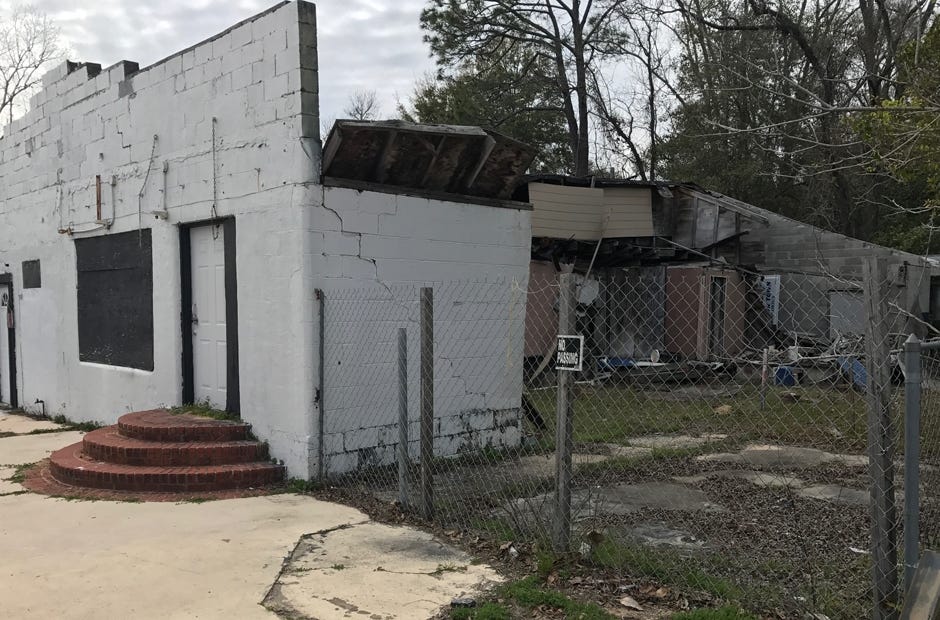![Structures like this one have caught the Crestview City Council's attention. [MARK JUDSON/NEWS BULLETIN]](http://127.0.0.1/wordpress/wp-content/uploads/2022/01/ghows-DA-4ac996f0-ba2d-6184-e053-0100007fd0dc-7be78a21.jpeg)
CRESTVIEW — The City Council is taking its fight against local blight to the next level with proposed ordinance 1619. The measure would modify Chapter 14 of the city code to include a definition of what deems a structure unsafe.
While it might seem obvious to an observer if a building is in disrepair, without a key piece of wording in the code, it prevents code enforcement officers from acting against a blighted building.
The wording in the Fort Walton Beach city code, for example, authorizes building officials to inspect any “structure or portion thereof, including electrical, gas, mechanical or plumbing systems which are unsafe or unsanitary or are otherwise dangerous to human life.”
Therefore, if a building has wires visibly dangling from the inside, the city can inspect the property and determine whether it violated city building codes. That process is more difficult, and sometimes not possible, under current Crestview code.
IMPACT ON PROPERTY OWNERS
Lack of this wording was first discussed during a Jan. 23 City Council meeting, and work on the ordinance began. A first reading was conducted March 13; the measure will receive a second reading before it goes to vote.
The ordinance appears to have the council’s full support, but not without slight hesitation to how it could later affect property owners.
Some officials would like to eventually authorize the city to condemn and demolish a building if it has fallen into disrepair and exceeds code enforcement punishment.
Councilman Joe Blocker has suggested area business owners attend a workshop to explain what incoming ordinances legally mean and what responsibilities they have.
Councilman Doug Faircloth is concerned the measure doesn’t go far enough to allow a right of entry into a potentially hazardous building and the ability to condemn it. He cited structures with loose wires or the possibility of homeless individuals starting interior fires on cold nights.
The city won’t be able to expand its ability to combat blighted buildings without this initial ordinance, Growth Management Director Teresa Galliard said during the March 13 meeting.
Calls to Galliard for comment on this story were not returned.
EFFECT ON CRIME
Dilapidated structures don’t just affect a city’s appearance; they can also play a role in crime rates.
"Cleaning up blighted areas and neighborhoods will likely drive crime away," Crestview Police Chief Tony Taylor said.
He’s observed similar reductions in other communities that have revitalized their downtowns, and the information is based on statistics.
"With community and law enforcement cooperation, and given sufficient manpower and resources to police these revitalized areas, Crestview will see a positive impact from addressing blight," he said.
The department’s public information officer, Brian Hughes, gave similar insight from his educational background in urban revitalization and design. The stronger code enforcement and ability to demolish condemned and unsafe structures will aid in downtown Crestview’s transformation, according to Hughes.
Strengthening of the city code and giving more authority to code enforcement officers has been a goal for the City Council for several months. The added ability will allow the city to impose legal action against property owners who let their buildings fall into disrepair and provide a backbone for preventing future incidents.
Ordinance 1619 is scheduled for its second reading and subsequent vote during the March 27 City Council meeting. Members of the public wishing to speak at the meeting can do so by completing a yellow comment card, found immediately outside the council chambers, and submitting it to City Clerk Elizabeth Roy.


This article originally appeared on Crestview News Bulletin: New ordinance targets city's blight
